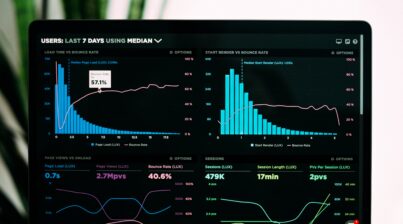Photo by Austin Distel on Unsplash
It’s important that HR leaders learn how to leverage people analytics to improve decision making, identify and predict workforce trends, measure the effectiveness of HR programs, and optimize employee engagement and retention. By using data and analytical tools, HR leaders can be great at people analytics by gaining a deeper understanding of their workforce and making data-driven decisions that can positively impact the organization’s overall performance and success. Additionally, people analytics can help HR leaders identify and address issues related to diversity, equity, and inclusion, and provide insights into how to build a more inclusive and equitable workplace. Let’s look at some ways to leverage people analytics.
What are the top ways for HR Leaders to leverage people analytics?
Responsible HR leadership and reporting means that HR metrics and key performance indicators (KPIs) are front and center. Here are some of the top ways that HR leaders can leverage people analytics:
- Recruiting: Use data to better understand the characteristics of successful employees, and to improve the effectiveness of recruiting efforts. This can include identifying the sources of the best candidates, determining the best interview questions, and evaluating the effectiveness of different recruiting methods.
- HR forecasting: Use data to predict workforce trends and potential issues. This will allow the company to proactively plan and make decisions on how to handle future workforce needs.
- Performance management: Use data to identify patterns and trends in employee performance, and to make more accurate performance evaluations. This can help managers to identify areas where employees need coaching or development, and to recognize employees who are excelling.
- Talent management: Use data to identify high-potential employees and to improve the way they manage talent. This can include identifying areas where employees need development and creating development plans for them.
- Employee engagement: Use data to identify the factors that contribute to employee engagement and to create an environment that promotes engagement. This can include identifying the factors that lead to high levels of engagement and taking steps to address areas where engagement is low.
- Employee retention: Use data to identify the factors that lead to employee churn and to develop strategies to reduce turnover. This can include identifying the most common reasons for employees to leave and taking steps to address them.
- Diversity, equity and inclusion (DEI): Use data to better understand and address disparities and issues related to DEI within an organization. This can include identifying areas where there are disparities in terms of recruitment, promotion, or performance, and taking steps to address them.
- Continuous monitoring and tracking: Continuously monitor and analyze data to track progress and to identify areas for improvement.
It is important to note that these are not mutually exclusive, and an effective people analytics strategy could involve integrating many of the above techniques to build a comprehensive picture of the workforce and identify areas where improvements can be made. That’s where Employee Cycle comes in providing organizations a way to have all of their people analytics visualized in minutes. Also, when implementing people analytics it is important to maintain transparency and trust among the employees. Ensure data security and take ethical concerns into account.
How Can An HR Leader Become Great At People Analytics?
To be great at people analytics, an HR leader needs to better understand reporting and analytics, integrations, metrics and KPIs, security and much more. Here are several steps to put into action to become an HR leader that is great at people analytics:
- Develop analytical skills: People analytics requires a deep understanding of data and analytical methods. So, it’s important for HR leaders to build their analytical skills. This can include taking courses, attending workshops, and learning to use different data and analysis tools.
- Understand the business: People analytics is most effective when it is aligned with the strategic goals of the organization. Therefore, it is important for HR leaders to have a good understanding of the business and how the workforce fits into the overall strategy.
- Be data-driven: HR leaders should be data-driven in their approach to decision making. They should be able to use data to support their decisions and be able to clearly articulate the insights that data provides.
- Communicate effectively: Being able to clearly communicate the insights from people analytics is important for being able to get buy-in from leadership and other stakeholders. The ability to effectively communicate the results and recommendations is key to making data-driven decisions and implementing change.
- Be ethical and transparent: People analytics relies on collecting and analyzing data on employees, so it is important that it is done in an ethical and transparent way. HR leaders should be aware of and follow any relevant laws and regulations, and be transparent about what data is being collected and how it is being used.
- Continuously learn: The field of people analytics is rapidly evolving, with new technologies, techniques, and best practices emerging all the time. It’s important for HR leaders to stay up-to-date and continuously learn about new trends and developments.
- Lead change: Using people analytics to drive change within an organization will require strong leadership. An HR leader should be able to build buy-in, navigate organizational politics, and lead cross-functional teams to achieve successful outcomes.
- Encourage data culture: Building a data culture within the organization will help to ensure that data-driven decision-making becomes a regular part of the way things are done. This can include creating a data-driven culture that fosters curiosity, continuous learning, and experimentation.
It’s important to keep in mind that while people analytics is an important tool, it’s not a replacement for human judgment or intuition. An effective HR leader will be able to balance the insights provided by data with their own experience and understanding of the organization and workforce.
Photo by Campaign Creators on Unsplash
Final Thoughts
Being great at people analytics can help an HR leader have a seat at the executive table by providing them with the ability to make data-driven decisions and demonstrate the value of HR initiatives to the overall success of the organization. By using data and analytics to identify and predict workforce trends, measure the effectiveness of HR programs, and optimize employee engagement and retention, an HR leader can show the executive team how their efforts are positively impacting the company’s performance. Additionally, people analytics can provide insights into areas such as diversity, equity, and inclusion, which can help an HR leader demonstrate the importance of these issues to the organization and contribute to the overall success of the company.
With the help of people analytics, an HR leader can provide data-driven insights and recommendations to the executive team on key business decisions such as workforce planning, talent management, and employee engagement. They can also use analytics to measure the impact of different HR programs, policies, and initiatives and make data-driven decisions about where to focus their efforts and resources.
In summary, HR leaders who are skilled in people analytics can provide valuable insights and recommendations to the executive team, demonstrate the impact of their work on the company’s performance and help drive business decisions. This can help them gain credibility and influence with the executive team and be seen as a valuable member of the leadership team.












